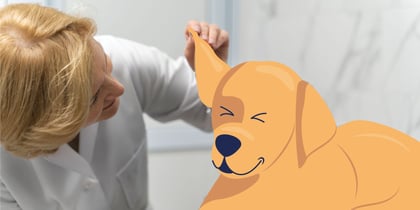Dog Ear Yeast Infections: Everything You Need to Know

Table of Contents
Dog ear infections are one of the most common problems we see in dogs. Any age, gender, breed, and size of dog can get an ear infection. Ear infections can be limited to one or both ears.
Key Takeaways:
- Dog ear yeast infections are caused by an overgrowth of yeast and can lead to painful symptoms, such as discharge and itching.
- Factors like hot and humid conditions, breed characteristics, and ear canal shape can contribute to ear yeast infections in dogs.
- Treatment involves using anti-fungal ear drops, medicated cleansers, oral antibiotics, and anti-inflammatory medications.
What Are Ear Yeast Infections in Dogs?
A dog ear yeast infection is a condition caused by an overgrowth of the yeast species called Malassezia pachydermatis, which normally resides harmlessly in the ear canal of dogs. When certain conditions allow this yeast to multiply uncontrollably, it can lead to an infection characterized by various symptoms.
Typically, the yeast overgrowth results in a painful and uncomfortable ear infection, often accompanied by a brown, crusty discharge. Dogs of any breed, age, gender, or size can be affected by ear yeast infections, but it is more common in breeds with long or very hairy ears.
What Causes Ear Yeast Infections in Dogs?
Yeast infections in a dog's ear can be caused by hot and humid conditions, breed characteristics, & ear canal shape. Here's the list of these causes further explained:
Hot and humid conditions
Hot and humid environments increase the risk of ear infections in dogs.
Breed characteristics
Breeds with long or very hairy ears, such as cocker spaniels or basset hounds, are more prone to ear infections. The long and hairy ears provide a favorable environment for yeast and bacteria to multiply.
Ear canal shape
Unlike human ear canals, which are straight, a dog's ear canal is L-shaped. This shape makes it easy for wax and fluid to get trapped, worsening the infection.
Dog Ear Yeast Infection Symptoms
A dog ear yeast infection can be a painful and uncomfortable experience for your dog. As a pet owner, it is important to be aware of the common yeast infection symptoms in your dog's ear, as early detection and treatment can prevent further complications.
Here’s a list of symptoms to look out for:
- Pink or red skin
- Brown, black, or burgundy discharge
- Bleeding, crusts, or scabs
- Persistent itching
- Hair loss
- Musty Odor
- Crying or vocalizing
- Head tilting and shaking
- Hearing loss
If you see any of the signs mentioned above, you should book a visit with your veterinarian. They will check your dog’s inner ear, looking for any objects stuck in the ears. They will also look closely to see if the tympanic membrane (the eardrum) is damaged. They will have a good look (and a sniff!) of the discharge, checking the color and consistency.
A swab of the discharge will be analyzed under the microscope. This will pick up any bacteria, yeast, or mites present in the ear and guide treatment.
Hassle-free In-Home Pet Sick Visits
When your pet isn't feeling well, the last thing you want is a stressful trip to the vet. Our in-home sick pet visits offer a calm, stress-free alternative.
Treating a Dog Ear Yeast Infection
Treating a dog's ear yeast infection involves using anti-fungal ear drops, medicated ear cleansers, topical medications, oral antibiotics, and anti-inflammatory drugs. Here's a breakdown of each available treatment:
Medications
Anti-fungal ear drops are the most common treatment for dog ear yeast infections. Your vet may also prescribe oral anti-fungal tablets and pain relief medication if your dog's ear is very painful. For severe infections, an ear flush under general anesthesia may be necessary.
Medicated Ear Cleanser
Regularly cleaning your dog's ears with a medicated cleanser can help prevent and treat ear yeast infections. Your vet can recommend a suitable product.
Topical Medications
To aid in clearing the infection, a topical medication like a cream or ointment may be recommended by your veterinarian for direct application to the affected ear.
Oral Antibiotics
In case of a secondary bacterial infection in your dog, your vet may prescribe oral antibiotics to help clear up the infection and prevent it from recurring.
Anti-Inflammatory Medications
To help reduce inflammation & pain associated with ear infections, your vet may prescribe anti-inflammatory medications such as steroids. These medications should only be used under your vet's supervision.
Related reading: Home Remedies for Ear Infections in Dogs
How to Clean Your Dog Ears with a Yeast Infection
Keeping your dog's ears clean is crucial to prevent ear infections. If your dog has a yeast infection, follow these steps before applying any ear medication:
- Choose the Right Solution: Opt for an ear-cleaning solution containing ketoconazole, known for its antifungal properties.
- Application Process: Apply the solution to the affected ear. Gently massage the base of the ear and use a clean cotton ball to wipe away excess solution and debris.
- No Cotton Swabs or Inserts: Avoid using cotton swabs or inserting objects into the ear canal to prevent damage.
For an in-depth guide, read: How to Clean Your Dog's Ears at Home.
Preventing Dogs from Scratching Their Ears
Ear yeast infections can be intensely irritating for your pet, leading them to incessantly scratch their ears. This scratching, especially with sharp nails, can exacerbate the condition by damaging the ear's skin, paving the way for more infections and discomfort.
- Use Protective Collars: You might have seen dogs with a big cone around their neck. This is called an Elizabethan collar. It stops dogs from scratching their ears. It might look funny, but it helps them heal faster.
- Maintain Short Nails: Long nails can hurt the ear more when they scratch. If you're not sure how to cut your dog's nails, ask the vet for help.
- Allergy Consultation: Recurring ear and skin infections might be a sign of allergies. If your dog frequently faces these issues, consult a veterinarian about potential allergy testing.
BetterVet Can Help
Ear infections are a common problem in dogs, and yeast infections are a frequent cause. Owners must pay attention to the signs and symptoms of ear infections and seek veterinary care promptly. Treatment options are available and can help alleviate discomfort and prevent further complications.
To ensure the best care for your furry friend, schedule a visit with a trusted veterinarian at BetterVet.






